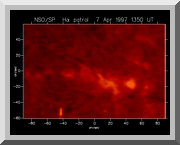





 Movie Credit: This film clip taken from a longer movie by Big Bear Solar Observatory of a flare that occurred on April 7, 1997. Click here to see if there are active regions on the Sun today. A surge prominence and associated flare near the solar limb. Courtesy of the National Solar Observatory/ Sacramento Peak, NOAO) |
Basic Facts about Solar FlaresSolar flares are explosions of incredible power and violence that release energy equivalent to about 100 hurricanes in a matter of tens of minutes. (To equal the power of a hurricane one would have to set off about a thousand nuclear devices per second for as long as the hurricane rages on.) To get a feel for the awesome power involved, here is an image of the destruction left in the wake of Hurricane Andrew , a small storm compared to a solar flare, but one of the most destructive hurricanes on record in the U.S. The strong and twisted magnetic fields in the vicinity of active sunspot groups are thought to provide the power that is released in the solar flares. It is not known as yet exactly how this occurs. Large quantities of xrays and hot particles may strike the Earth following a solar flare event. The xrays arrive in just 8 minutes time and the hot particles follow several hours later. The strongest flares occur only several times per year even in solar maximum. Weaker flares are relatively common. Several tens of these weaker flares can occur in one day during active periods.
|